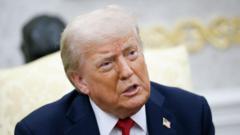Southeast Asian economies are navigating uncertain waters as Trump's potential tariffs threaten trading relations with both China and the U.S. Local businesses are bracing for the fallout, struggling to compete against Chinese imports while maintaining their growing exports to American markets.
Southeast Asia Faces Dilemma Amidst Trump's Tariff Looming

Southeast Asia Faces Dilemma Amidst Trump's Tariff Looming
As Donald Trump considers new tariffs, Southeast Asian nations must choose between maintaining ties with China and reinforcing their dependency on the U.S. market.
Southeast Asian countries are standing at a crossroads as the specter of renewed tariffs under U.S. President Donald Trump threatens to complicate their economic landscape. The past few years have seen a shift in trade dynamics, particularly after Trump imposed tariffs on Chinese goods, prompting Vietnamese entrepreneurs like Hao Le to seize opportunities arising from the changing market. Le's company, SHDC Electronics, has thrived, selling $2 million of phone and computer accessories monthly to the United States. Yet, his fortune hangs in the balance, as a proposed 46% tariff on Vietnamese products looms in the distance, potentially disastrous for many local businesses.
Trump's initial tariffs inadvertently transformed Southeast Asia into a hub for Chinese goods rerouted away from the U.S. market, impacting local manufacturers who struggled to compete while simultaneously opening doors for new players in various industries. However, the specter of increased tariffs could again stifle growth for economies like Vietnam and Indonesia, both of which have aspirations of becoming major players in sectors like electric vehicles and semiconductor manufacturing.
Chinese President Xi Jinping's recent visits to several Southeast Asian nations highlight the delicate balance these countries are trying to maintain between their longstanding economic relationship with China and their need to foster ties with the U.S. Malaysia's trade minister emphasized that there would be no choice between the two superpowers, underlining the region's precarious position.
Following the announcement of Trump's tariffs, countries in the region sprang into action. Vietnam even proposed eliminating tariffs on U.S. goods to reinforce its importance in the economic equation, while Thailand sought to bolster imports from the U.S. in hopes of avoiding potentially crippling tariffs. The Association of Southeast Asian Nations (ASEAN) has chosen a cautious route, refusing to retaliate against Trump's decisions, while attempting to highlight its significant trade partnerships with the U.S.
Potential tariffs threaten countries like Indonesia, which could see up to a 32% levy, while Malaysia braces for a 24% tariff. The looming reality is particularly severe for Cambodia, where a staggering 49% tariff could substantially hinder growth in a nation that has thrived as a trans-shipment hub for Chinese goods.
Despite the challenges, some Southeast Asian businesses see potential gains if U.S. buyers begin to diversify their supply networks. In fact, American buyers are reportedly making quicker decisions to switch suppliers, with Southeast Asia's robust capabilities positioning the region favorably amid these changes.
In contrast, many local businesses face an influx of ultra-cheap Chinese imports, leading to closures and layoffs across the region. The specter of protectionism is rising as governments grapple with the need to safeguard local industries from the aggressive competition introduced by China's lower-priced products.
As Southeast Asia navigates this complex terrain, the looming threat of Trump’s tariffs serves as a wake-up call for the region. It underscores a growing need to address over-reliance on specific trade relationships while preparing for possible shifts in global supply chains. The stakes are high, with economic futures hanging in the balance as these nations attempt to balance their relationships with both China and the United States.




















